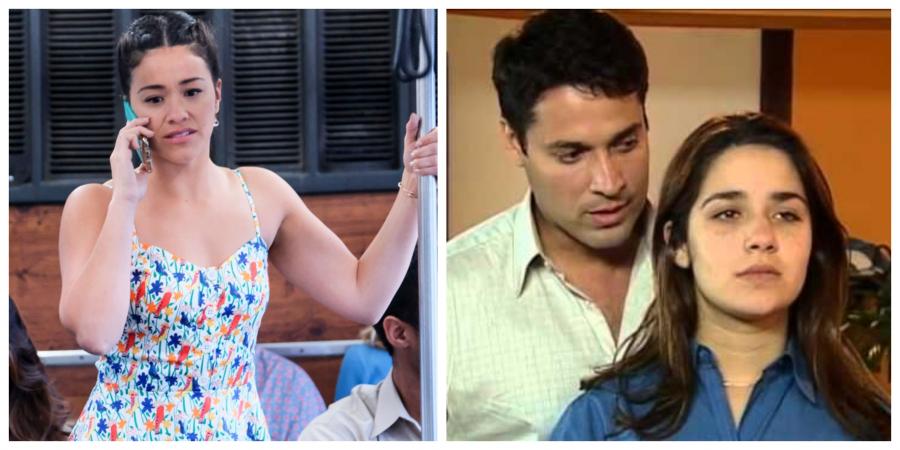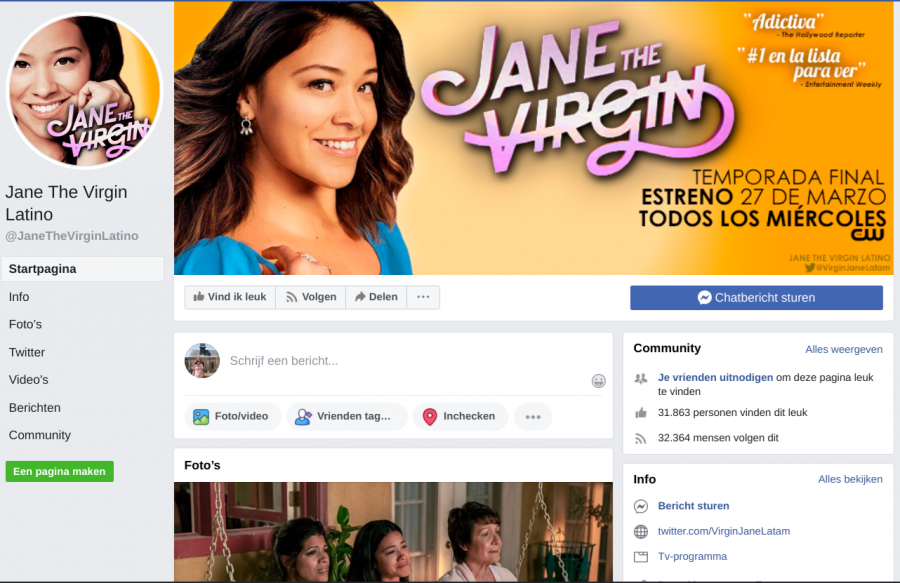
Jane The Virgin: a westernized telenovela
Warning: This article contains spoilers for Jane the Virgin
Jane the Virgin is an award-winning show by The CW Television Network. The show centers around Jane Villanueva, a woman who is accidentally artificially inseminated. It generally portrays sequences of unthinkable events alternating with heartwarming scenes.
Jane lives with her free-spirited mother Xiomara, who had Jane at 16, and her highly religious grandmother Alba (or "Abuela"), who migrated from Venezuela. Together they have spent many hours watching telenovelas, and the element of Latin American culture in their lives is evident. This article will show how the five-season series represents the Latin American telenovela in a westernized way, how this is both a result of and a contribution to globalization and how it fits into Appadurai’s theory of global cultural flows.
Is Jane the Virgin a telenovela?
“A telenovela is a limited-run serial dramatic programming popular in Latin American, Portuguese, and Spanish television programming. (...) Due to the similarities between the telenovela and the American soap opera, the telenovela format is also colloquially known as a "Spanish soap opera" in the United States. While most English language soap operas can continue indefinitely, almost all telenovelas run for a predetermined duration. They are usually shown five or six days a week and run for an average of 120 episodes.”
Referring to the above definition, it seems questionable to say that Jane the Virgin is a telenovela. Jane the Virgin aired once a week between 2014 and 2019, notably less than "five or six days a week." Also, in 2018, the show was renewed for a fifth season, so the ending was not really predetermined. The show did end at episode 100, which is close to the average of 120, but due to the limited number of days on which episodes aired, it took a lot more years than the average telenovela.
The word "telenovela" is a combination of the Spanish words "tele" (short for "television") and "novela" (meaning "novel"). Jane the Virgin’s episodes are called chapters, and every chapter ends with "to be continued…," resembling a novel. Telenovelas can be recognized by many recurring plotlines. Examples include: an evil twin appearing suddenly, love triangles, love between rich and poor, big family secrets, injuries, death, unexpected pregnancies, and paranormal activity, like ghosts and talking objects. The latter is also known as magical realism, a way of storytelling mainly used in Latin American literature, where realistic scenes have elements of unrealistic fiction. Jane the Virgin uses all of these storylines, and most notably magical realism. On multiple occasions, lifeless objects start talking to Jane about her problematic indecisiveness, helping her to look at her dilemma from an outside-viewpoint. Most of the time, magical realism represents a turning point in Jane’s behavior, or even in the plot of the show. The phenomenon of magical realism is explained by a narrator as something that can be frequently seen in telenovelas, in one of the many attempts the show makes to teach viewers about the cultural aspects that the show wants to represent. An example of a scene featuring magical realism in Jane the Virgin can be seen below.
While guiding viewers through the insane plot, the narrator emphasizes how the show strongly resembles the plotlines of a telenovela with lines like “straight out of a telenovela, right?” The show was meant to honor telenovelas in a western way. It even is loosely based on the Venezuelan telenovela Juana La Virgen. As Jennie Snyder Urman, the executive producer, puts it: “I didn’t want to do a satire. (...) I kept reminding myself that I’m writing love letters to the telenovela.” Towards the end of the show, the narrator talks more and more about how telenovelas end with a wedding. While keeping the viewers curious and attentive (how is the love-triangle going to be resolved?), it is a constant reminder that the viewer is watching a telenovela of some sort. Fortunately for some, the final episode does end with a wedding. “As you well know, because I’ve been telling you, telenovelas end with a wedding. And after a long journey, we are finally at ours,” are the narrator’s first words in the final scene.
When Jane and her new husband kiss, white leaves fall from a tree. This is yet another hint at a telenovela trope. Every time Jane kisses someone she truly loves, something white falls down on them. This could be debris from a ceiling, paper planes, flower petals or whatever the writers could come up with that would fit in the story. Every time a loved one comes near Jane, a little guitar song plays, and every time Jane thinks about someone she loves, an orange “warm” heart appears on her chest. The writers seem to have really put thought into these returning symbols to keep the story coherent, something that also regularly happens in telenovelas.

White leaves fall down on kissing Jane and Rafael
Jane's wedding scene ends with the two newly-weds sitting against a tree. “What happens at the end of your book?” asks Rafael, Jane’s husband. Jane has been an aspiring writer since season one, and in all seasons she can be seen working on her book and trying to get it published. Her book describes the crazy events that happened since she first got accidentally artificially inseminated, as well as the history of her family. It is basically an autobiography although the characters have fictitious names. “They make it into a telenovela,” Jane answers Rafael. “Well, who would want to watch that?” Rafael jokingly says. The scene ends with Jane and Rafael disappearing in a white heart, while Jane winks to the viewers. This is remarkable because, excluding the presence of a narrator, the fourth wall is rarely broken. This could be seen as a playful hint: Because Jane’s book is a story about her life, and Jane the Virgin is also a story about Jane’s life, it could be concluded that the show you are watching is, in fact, the show that Jane wrote about in her book about her own life. If this is the case, this is another example where the show self-identifies as a real telenovela.
A meta-telenovela
To add another layer to the telenovela paradigm, Jane the Virgin could be called a meta-telenovela. In the first season, Jane finds out that her father is telenovela star Rogelio de la Vega, who plays the lead in the Passions of Santos, a telenovela loyally watched by the Villanuevas. There are many scenes revolving around the filming of the Passions of Santos, from the writing process to the behind-the-scenes of the recording. To put it simply: the Passions of Santos is a telenovela in a telenovela.
A real-life telenovela-star who stars in an American telenovela, playing a telenovela-star trying to bring a telenovela to America.
To make things more interesting, Rogelio tries to bring the Passions of Santos to the US, calling it the Passions of Steve and Brenda. This, of course, resembles the journey of Juana La Virgen to American television as Jane the Virgin. On top of that, he goes to The CW (the network that produced Jane the Virgin) to ask them to produce the Passions of Steve and Brenda. To top it all off: Jaime Camil, who plays Rogelio de la Vega, did not have to audition for Jane the Virgin because he already was a big star who was familiar with “telenovela stuff”. A real-life telenovela-star who stars in an American telenovela, playing a telenovela-star trying to bring a telenovela to America.
Jane the Virgin as a culture scape
Arjun Appadurai proposed a theory to explore the complex current global cultural economy in the context of globalization. By looking at the relation between five cultural flows, also called scapes, he made it possible to analyze the effects and influences of globalization (Appadurai, 1990). By applying Appadurai’s theory to Jane the Virgin, it will become clear how this telenovela is both a result of and a contribution to globalization.
According to Appadurai, ethnoscapes represent the mobility of people. Nowadays, more people want or have to move, and move to farther-away places. In the series, the story of Alba’s immigration is told: She wanted to move from Venezuela to the United States because she was shamed for having premarital intercourse. She is just a character in a show, but her story is not unrealistic, it resembles the journey of many immigrants.
Technoscapes represent the rapid movement of technology across borders. An example of this is the internet as infrastructure, more on which will be discussed below. Through the internet, information can be shared, which in this case comes in the form of a telenovela.
This can be connected to finanscapes: the rapid movement of money and commodities in the world. Viewers pay for the broadcasting and streaming of the show, and the broadcasters and streaming services pay that money to the producers of the show for the streaming license. This way, money circulates all over the world, across borders.
The show contributes to globalization by creating a movement of media, technology, and money across borders.
Mediascapes represent the way information or media is distributed. As will be discussed, the internet, streaming services like Netflix, and television channels make it possible for people all over the world to see the show and the cultures that it wants to represent.
Mediascapes closely connect to ideoscapes: the images that are put across have to do with ideologies. The reason that Jane the Virgin got its name is that Jane is still a virgin when she gets pregnant. Her highly religious grandmother often tells her that premarital intercourse is a sin, and this, combined with the praying before every meal and going to church, forms a clear image of the first-generation immigrant’s ideologies. It is apparent that with Jane's mother Xiomara, the next generation, these ideologies have been toned down since she had Jane as a teenager. Jane tries to keep her promise to Alba but is not as strictly religious as her. The series also shows the ideologies of its writers since we can see in their writing that homosexuality is normalized and abortion is discussed.
So, in short, both the characters and the storyline of Jane the Virgin are obvious results of globalization, and the show contributes to globalization by creating a movement of media, technology, and money across borders.
Infrastructures
Jane the Virgin is loyally watched in various countries all over the world. To use the Netherlands as an example, Jane the Virgin was broadcasted on TV channels NET5 and SBS9, and the first four seasons can also be found on Netflix. Netflix has a deal with The CW, which means that they have the license to offer series produced by The CW in many countries, but not all. This has to do with the fact that Netflix cannot always buy a license for every region. In countries with free access to the internet, there are also torrent websites where the show can be downloaded from for free.
The current stage of globalization is defined by new technologies and infrastructures, the main one being the internet. Because of the internet, Netflix and various other streaming services, the westernized telenovela can be shared with people all over the world who have access to these technologies, which makes Jane the Virgin both a techno- and mediascape, according to Appadurai's definitions. Another infrastructure of globalization, in this case, is the physical shipping of Jane the Virgin on DVD. This makes the show more available to margins that do not have the same access to the internet as the centers (Wang et al., 2013).
A westernized telenovela
Jane the Virgin represents the Latino community and its culture without making it the sole focus of the series. This way, it is enjoyable and recognizable for Latino or Hispanic viewers, but also for viewers of other ethnicities. Ben Silverman, the executive producer of the show, aimed for the show to be “an homage to the telenovela but still (...) uniquely American and play to a general market.” Jane the Virgin, compared to the original Venezuelan version Juana La Virgen, uses a brighter color-palette and the story is told at a much faster pace to give in to the American need for speedy storytelling. The main language of the show is English, but Alba, who is a first-generation immigrant, speaks Spanish most of the time, even when the other participants in the conversation are speaking English. Although the character does know how to speak English, and fully understands it, she was always meant to speak Spanish. It makes the show more authentic because it resembles the situation of many bilingual families. This, of course, speaks to the Hispanic viewers and gives them yet another aspect that reminds them of their heritage. For the viewers that do not understand Spanish, subtitles are added. It engages them in the conversation, without losing the cultural aspect in the process. In technical terms, Jane the Virgin embodies an englobalized phenomenon - the telenovela - which is deglobalized and locally implemented, resulting in a polycentric westernized telenovela (Blommaert, 2010).

A scene of Jane the Virgin (left) and a scene of Juana La Virgen (right). A difference in colors can be clearly seen.
Diaspora of Latinx people
In 2014, the year Jane the Virgin first aired, over 55 million Hispanics lived in the United States, making up 17% of the population. This diaspora of Latinx people, mixed with the current niche-culture, provided an ideal opportunity for a multicultural show like Jane the Virgin to succeed. Several Facebook groups have been created about Jane the Virgin, but centered around specific countries or ethnicities; for example, there is a “Jane the Virgin Latino” group. Considering this group also includes Latinx migrants, this can be connected to transnational nationalism, the phenomenon whereby foreigners feel a shared connection to their home country, and strengthen this by participating in online activities with others from the same country. This adds to the strengthening of their national identities (Eriksen, 2017; Castells, 2010).
Jane the Virgin represents a full circle of globalization.
In 2015, Jane the Virgin was launched in Latin America, dubbed in Spanish. This is somewhat ironic: a westernized telenovela is launched in Latin America, the center of telenovelas. Jane the Virgin represents a full circle of globalization: the idea of telenovelas has traveled to America, where it was adapted for the American audience, and then sent back to its roots, where it was adapted for the Latin American audience by getting dubbed in Spanish. This constitutes a good example of the polycentricity and superdiversity that exists in today’s society (Vertovec, 2007).

A screenshot of the Jane the Virgin Latino group
To conclude
In Jane the Virgin, the characteristics of a telenovela are evident, but with a new, westernized twist. Jane the Virgin has made telenovelas, together with Latin American culture, known in the United States and the rest of the world in the form of a five-season series. It speaks to the diaspora of Latinx people in the United States, but also to people of different ethnicities because it is a polycentric show, focused on our current superdiverse society. The show has been distributed through TV broadcasting, the internet, Netflix and the physical shipping of DVDs as infrastructures. It thus constitutes both a result of and a contribution to globalization.
References
Appadurai, A. (1990). Disjuncture and Difference in the Global Cultural Economy. Theory, Culture & Society, 7(2-3), 295–310. doi: 10.1177/026327690007002017
Blommaert, J. (2010). The Sociolinguistics of Globalization. Cambridge: Cambridge University Press.
Castells, M. (2010). The Rise of the Network Society. Second Edition with a New Preface. Wiley Blackwell
Eriksen, T. H. (2007). Nationalism and the Internet. Nations and Nationalism, 13(1), 1–17.
The CW. (2014). Jane the Virgin. Miami, Florida.
Vertovec, S. (2007). Super-diversity and its implications. Ethnic and Racial Studies, 30(6), 1024–1054. doi: 10.1080/01419870701599465
Wang, X. et al. (2013). Globalization in the margins. Tilburg Papers in Culture Studies 73.